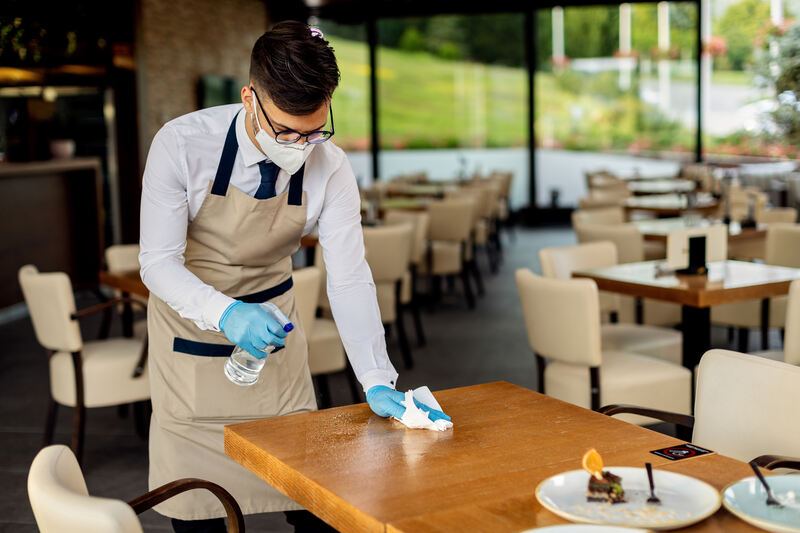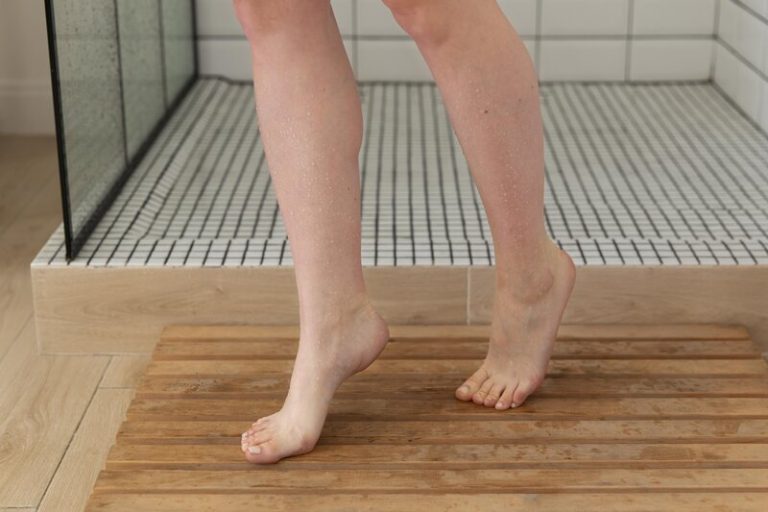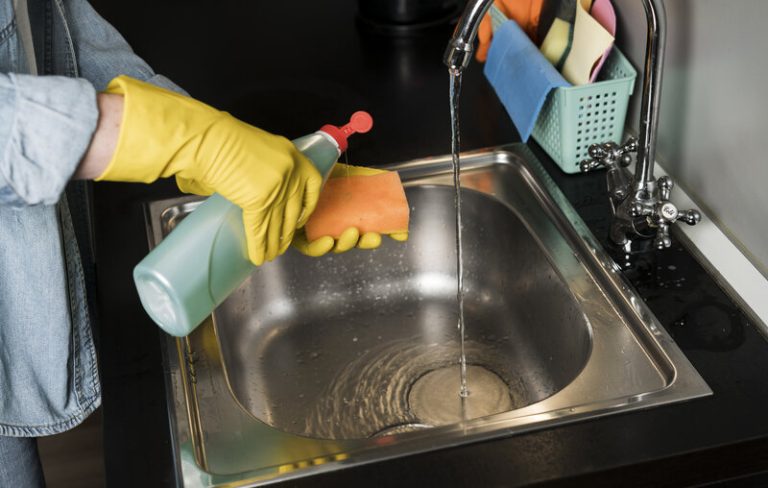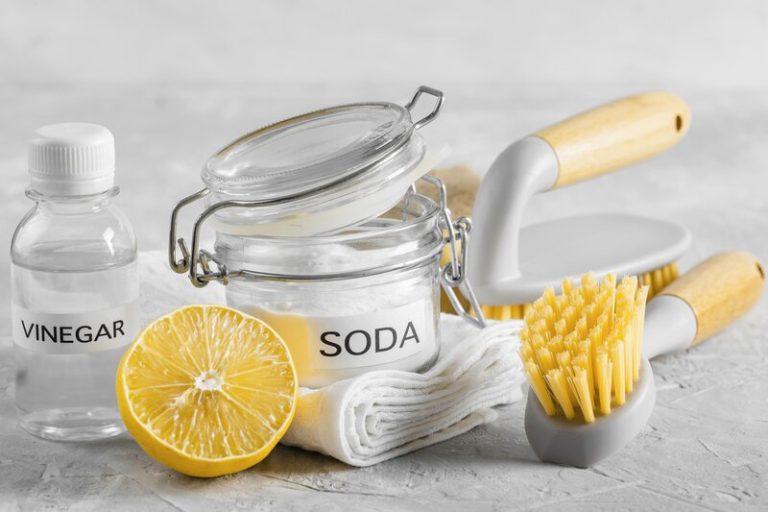Running a restaurant involves more than just serving delicious food to customers. It also involves maintaining a clean and sanitary environment to ensure the health and safety of both customers and employees. Therefore, the owner must know about the complete restaurant cleaning guide.
In this article, we will explore cleaning procedures in restaurants, the importance of this activity, the different areas that need to be cleaned, essential cleaning supplies, creating a cleaning schedule, and the best practices of implementing restaurant cleaning procedures that can be done to the fullest.
Whether you own a small cafe or a high-end restaurant, this restaurant cleaning guide will help you keep your establishment clean and in compliance with health regulations.
The Importance of Restaurant Cleaning
When it comes to a restaurant cleaning guide, the first thing you should know is why it is important to do so.
Maintaining cleanliness in a restaurant is crucial for several reasons. It not only ensures compliance with food safety regulations set by authorities like the Food Standards Agency but also plays a vital role in creating a positive impression among customers regarding the restaurant’s hygiene standards.
Health inspection standards further emphasize the significance of maintaining a clean restaurant. Regular cleaning helps prevent the spread of foodborne illnesses and bacteria, ensuring the safety of customers. Meeting these standards not only protects the well-being of patrons but also shields the business from legal implications and potential fines. Customer perceptions heavily influence the success of a restaurant. A clean establishment indicates professionalism and care, leading to heightened customer satisfaction and loyalty.
The Different Areas that Need to be Cleaned in a Restaurant
If you’re wondering how to clean a restaurant, it basically involves a variety of areas that require careful attention. These spaces include the dining area, kitchen, toilets, bar area, and storage areas, each demanding specific cleaning protocols to maintain hygiene standards.
- For the dining area, regular wiping down of tables, chairs, and menus is essential to prevent the spread of germs.
- In the kitchen, deep cleaning of cooking equipment, countertops, and floors is crucial to avoid cross-contamination.
- Toilets need frequent sanitisation of sinks, toilets, and floors to ensure a clean environment for customers.
- The bar area requires diligent cleaning of bar tops, glasses, and utensils to maintain a hygienic serving space.
- Storage areas must be organised and cleaned to prevent pests and maintain food safety.
If you are still puzzled, here is a restaurant cleaning guide that further discusses what areas need to be cleaned in a restaurant.
a. Dining Area
The dining area in a restaurant is a crucial space that requires regular cleaning and maintenance to ensure a pleasant dining experience for customers. Cleaning cloths, surface cleaners, and diligent cleaning routines play a key role in upholding cleanliness standards in this area.
In terms of cleaning the dining area, attention to detail is essential. Starting with the tables, table sanitisation is paramount to prevent the spread of germs and maintain hygiene. Using appropriate cleaning agents that are effective yet safe for food surfaces is crucial. The floors should not be overlooked; regular sweeping and mopping are necessary to keep the area tidy and free from debris. Creating a welcoming ambience involves not just cleanliness but also proper lighting, decor, and air quality management.
b. Kitchen Area
The kitchen area of a restaurant requires thorough cleaning due to the food preparation activities that take place. Utilising cleaning gloves, and disinfectant sprays, and following a comprehensive deep cleaning checklist are essential to maintain cleanliness and food safety standards in the kitchen.
In terms of equipment cleaning, it’s crucial to regularly clean and sanitise all kitchen tools and appliances. For example, the grills should be scraped and wiped down after each use, whilst the fryers require daily filtering and cleaning to remove built-up grease and food particles.
Grease removal is a significant aspect of kitchen cleaning. Using degreasers and hot, soapy water to tackle grease buildup on surfaces, walls, and vents can help prevent fire hazards and maintain a hygienic environment.
Sanitation practices are also paramount in the kitchen. Ensuring that all surfaces, including countertops and cutting boards, are sanitised with approved cleaning solutions after each use can prevent cross-contamination and foodborne illnesses.
c. Restrooms
Toilets in a restaurant require special attention as they are a reflection of the establishment’s overall cleanliness. Using appropriate cleaning solutions, and mops, and following a front-of-house deep cleaning checklist are essential to ensure hygienic toilet facilities.
Regular disinfection of high-touch surfaces such as door handles, taps, and toilet flush handles is crucial in preventing the spread of germs. Maintaining a clean and fresh-smelling environment involves using odour control products like air fresheners or sanitising sprays.
Proper maintenance practices include promptly addressing any plumbing issues, ensuring adequate ventilation, and regularly inspecting for leaks or damages. Staff training on cleaning protocols and scheduling periodic deep cleanings contribute to upholding toilet cleanliness standards.
d. Bar Area
The bar area of a restaurant is a hub of activity that requires regular cleaning to maintain hygiene and presentation standards. Using appropriate equipment such as buckets, and floor cleaners, and following established cleaning procedures are essential for a clean and inviting bar area.
In terms of glassware sanitation, it is crucial to wash them thoroughly using hot water and detergent, then sanitize them using a commercial glass sanitizer to ensure germ-free serving vessels. Worktop cleaning should be done with a food-safe disinfectant, paying extra attention to areas where spills are common, such as near the drink dispensers. In case of spills, prompt action is key –
- for liquid spills, absorb and clean using a mop or absorbent towels
- for solid spills, scoop or scrape the spill before cleaning
to prevent accidents and maintain a safe environment for both staff and customers.
e. Storage Areas
Storage areas in a restaurant are vital for maintaining ingredient freshness and organization. Regular cleaning, including vacuuming, disposal of expired items using rubbish bags, and following a monthly cleaning checklist, is essential to prevent contamination and ensure food safety.
Proper organization of these storage spaces plays a crucial role in efficiency and stock rotation. Implementing a labelling system, grouping similar items together, and keeping high-demand products easily accessible can streamline kitchen operations.
- In terms of pest control, sealing cracks and using tight-fitting lids on containers are fundamental in preventing infestations.
- Sanitation measures such as regular disinfection of surfaces, including shelves and floors, help eliminate bacteria and pathogens that could compromise food quality.
The Essential Cleaning Supplies for a Restaurant
Any discussion about restaurant cleaning guide is certainly inseparable from the list of cleaning equipment needed to support this activity.
Using the right cleaning supplies is paramount for effective restaurant cleaning. Essential supplies include cleaning solutions, various cleaning tools such as mops and brooms, and personal protective equipment (PPE) to ensure the safety of the cleaning staff.
One of the most crucial components in the realm of restaurant cleaning is the choice of cleaning solutions. These solutions, whether disinfectants, degreasers, or sanitizers, play a vital role in eliminating germs and maintaining a hygienic environment.
Using the appropriate cleaning tool for a specific task is key; mops are ideal for large floor areas, while brooms effectively sweep debris. Personal protective equipment (PPE) like gloves and masks shield cleaning staff from harmful chemicals and potential contaminants, highlighting the importance of safety precautions in the cleaning process.
a. Cleaning Solutions
Cleaning solutions are the backbone of effective restaurant cleaning, as they help combat germs and maintain hygiene standards. Disinfectant sprays, surface cleaners, and specialised cleaning solutions are essential for different surfaces and areas within the restaurant.
Disinfectant sprays are particularly crucial in eliminating harmful bacteria and viruses from high-touch surfaces like tables, door handles, and menus. On the other hand, degreasers are essential for removing grease buildup from kitchen equipment and countertops, ensuring a safe working environment. Additionally, sanitizers play a vital role in reducing the spread of foodborne illnesses by killing germs on food contact surfaces. Choosing the right cleaning solutions tailored to specific needs is key to maintaining a clean and healthy restaurant environment.
b. Cleaning Tools
Cleaning tools play a vital role in ensuring thorough and efficient cleaning in a restaurant. Essential tools such as brooms, vacuums, mops, and buckets aid in removing debris, and dirt, and maintaining cleanliness in various areas of the establishment.
Aside from the traditional tools, specialised equipment like steam cleaners and floor scrubbers are also critical for tackling tough stains and maintaining hygiene standards. Regular maintenance of these tools is crucial to ensure their effectiveness and longevity.
It’s essential to have a designated storage area for cleaning tools to prevent cross-contamination and ensure easy access when needed. Implementing a cleaning schedule and training staff on the proper use of these tools is key to maintaining a sanitary environment in a restaurant.
Investing in high-quality cleaning tools not only improves the efficiency of the cleaning process but also contributes to the overall hygiene and reputation of the establishment.
c. Personal Protective Equipment (PPE)
Personal Protective Equipment (PPE) is essential for the safety of cleaning staff while performing cleaning tasks in a restaurant. This includes items such as cleaning gloves, masks, and protective clothing to prevent exposure to chemicals and contaminants.
In terms of maintaining a hygienic environment in a restaurant, proper PPE not only ensures the safety of the staff but also plays a crucial role in upholding health and sanitation standards. Cleaning gloves protect hands from harsh cleaning chemicals, masks shield the respiratory system from inhaling harmful particles and specialised protective clothing safeguards against splatters and spills.
PPE is designed to reduce the risk of injuries, illnesses, and cross-contamination, creating a safer workspace for all employees.
How to Create a Restaurant Cleaning Schedule?
Establishing a comprehensive cleaning schedule is essential to ensure all areas of a restaurant are consistently cleaned and maintained. This includes daily, weekly, and monthly cleaning tasks that help uphold hygiene standards and operational efficiency.
When setting up a restaurant cleaning schedule, it’s crucial to assess the frequency of tasks based on the footfall and type of cuisine served.
Regular
- Cleaning of dining areas
- Kitchen
- Restrooms
- Storage spaces
Allocate specific responsibilities to staff members, outlining clear duties for each shift. Consistency is key to maintaining a spotless environment; therefore, it’s vital to emphasise the importance of adhering to the schedule. Incorporating deep cleaning tasks, such as degreasing kitchen equipment and sanitising surfaces, on a monthly basis ensures thorough cleanliness.
a. Daily Restaurant Cleaning Checklist
Daily cleaning tasks are essential for maintaining cleanliness and order in a restaurant on a day-to-day basis. These tasks include cleaning procedures such as surface sanitisation, rubbish removal, and ensuring the overall tidiness of the premises.
Aside from the general cleaning tasks, specific areas in a restaurant require special attention to keep them presentable. High-traffic areas like the entrance, bar, and dining areas should be cleaned frequently throughout the day to ensure a clean appearance for customers. Staff members should regularly check and clean toilets, ensuring they are properly stocked with hygiene supplies such as hand soap, kitchen roll, and toilet roll. It’s crucial to have a structured cleaning schedule that assigns responsibilities to different team members for efficient management of these tasks.
b. Weekly Restaurant Cleaning Checklist
Weekly cleaning tasks in a restaurant focus on deeper cleaning and maintenance activities that may not be required daily. This includes tasks such as deep cleaning kitchen equipment, sanitising storage areas, and thorough floor cleaning.
Specialised cleaning procedures are also crucial during weekly maintenance cycles. These procedures involve cleaning extract hoods to prevent build-up, descaling coffee machines to maintain optimal performance, and disinfecting high-touch surfaces to ensure a hygienic environment for both staff and customers. Conducting stock checks is essential to monitor stock levels, prevent waste, and reorder supplies promptly. This comprehensive approach to weekly cleaning not only enhances the overall cleanliness of the restaurant but also contributes to the efficiency and longevity of equipment and resources.
c. Monthly Restaurant Cleaning Checklist
Monthly cleaning tasks in a restaurant involve comprehensive deep cleaning and inspection processes to ensure all areas are thoroughly maintained. Tasks include detailed equipment cleaning, exhaust system maintenance, and pest control measures.
One of the most critical aspects of monthly deep cleaning in a restaurant is the thorough inspection and cleaning of ductwork and vents. These hidden areas can accumulate grease, dust, and debris over time, creating a potential fire hazard and compromising indoor air quality. Regular cleaning of these specialised areas not only improves the overall hygiene of the restaurant but also ensures a safer environment for both customers and staff. The deep cleaning of storage shelves is essential for preventing cross-contamination and maintaining proper food safety practices.
Best Practices for Restaurant Cleaning
When looking at restaurant cleaning guide articles, you probably also want to know what the best practices are for restaurant cleaning, right?
Basically, adhering to best practices in restaurant cleaning is essential for maintaining high hygiene standards, ensuring food safety, and creating a healthy environment for customers and staff. Following established cleaning guidelines, training employees on proper procedures, and regular equipment maintenance are key aspects of effective restaurant cleaning.
One effective method employed in restaurant cleaning is the use of colour-coded cleaning supplies. This system helps prevent cross-contamination by assigning specific colours to different areas or tasks. For instance, using red cloths and mops for restrooms and blue ones for general cleaning areas.
Implementing proper cleaning techniques such as wiping down surfaces, disinfecting commonly touched areas, and thorough floor cleaning is crucial to ensure a clean and sanitary environment.
Employee training is also vital – staff should be educated on the importance of hygiene, how to use cleaning chemicals safely, and the proper way to clean different surfaces.
Regular maintenance protocols should include checking and cleaning equipment like exhaust systems, refrigerators, and cooking appliances to prevent dirt buildup and ensure they function efficiently.
a. Use Colour-Coded Cleaning Supplies
Utilising colour-coded cleaning supplies is a common practice in restaurants to prevent cross-contamination and ensure proper usage in designated areas. This system helps streamline cleaning processes, enhances efficiency, and upholds hygiene standards.
By assigning specific colours to different cleaning tasks or areas, staff members can easily identify the right tools for the job, minimising errors and promoting consistency. For example, red could be designated for high-risk areas like restrooms, while green might be used for general surface cleaning.
Colour-coding simplifies training for new employees as they quickly grasp the associated colours and their corresponding tasks, ensuring uniformity in cleaning practices throughout the establishment.
Regular maintenance of colour-coded supplies is essential to sustain the system’s effectiveness. This includes monitoring inventory levels, replacing worn-out items, and conducting periodic audits to ensure compliance with the colour-coding scheme.
b. Follow Proper Cleaning Techniques
Adhering to proper cleaning techniques is essential for effective removal of dirt, grease, and contaminants in a restaurant environment. Using appropriate tools such as scrubbing brushes, and floor cleaners, and following recommended cleaning guidelines ensures thorough cleaning and maintains hygiene standards.
Proper cleaning techniques not only help in maintaining a clean and sanitary work environment but also play a crucial role in upholding the reputation of a restaurant. By using appropriate tools like degreasers, sanitizers, and disinfectants, staff can effectively eliminate harmful bacteria and prevent cross-contamination. Establishing a routine cleaning schedule and following precise cleaning methods for different areas in the kitchen, dining, and restrooms helps in preventing foodborne illnesses and ensuring customer satisfaction. Observing proper safety precautions, such as wearing protective gear and handling chemicals properly, is imperative to safeguard the well-being of both employees and customers.
c. Train Employees on Cleaning Procedures
Training employees on proper cleaning procedures is essential to ensure consistency and efficiency in maintaining cleanliness standards in a restaurant. Providing hands-on training, clear guidelines, and ongoing support helps employees understand the importance of hygiene and follow established cleaning protocols.
Employee training goes beyond just initial onboarding; it involves ongoing education to keep up with new techniques and equipment in the industry. This continuous learning process helps staff stay updated and ensures they are equipped to handle any cleaning challenges that may arise.
Along with regular training sessions, reinforcement strategies like performance evaluations, quality checks, and feedback mechanisms play a crucial role in maintaining high cleanliness standards. These strategies not only motivate employees to adhere to cleaning protocols but also help identify areas for improvement.
d. Regularly Inspect and Maintain Equipment
Regular inspection and maintenance of cleaning equipment are critical to ensure their proper functioning and longevity.
Conducting routine checks helps in identifying potential problems early on, preventing costly breakdowns that can disrupt daily operations in a busy kitchen environment. By promptly addressing any issues that arise, restaurant staff can maintain a sanitary and efficient workspace, promoting food safety and customer satisfaction. Adhering to health inspection guidelines not only ensures compliance but also showcases a commitment to upholding high standards of cleanliness and hygiene, which are essential in the food service industry.
Finally, with this comprehensive restaurant cleaning guide, you now have a deeper understanding of the importance of maintaining cleanliness in your restaurant.
Elevate the cleanliness standards of your restaurant by opting for TEKA Cleaning’s professional commercial cleaning services. Book now or give us a call at 01233 751 544 to ensure the highest level of cleanliness and hygiene for your establishment.
Invest in reliable and efficient restaurant commercial cleaning services from TEKA Cleaning, and uphold the reputation and safety standards of your business.
Read also:











